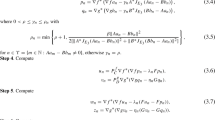Abstract
The authors analyze the two-stage Popov method with Bregman divergence and a new adaptive rule for choosing the step size, which does not require the Lipschitz constants to be known and operator values at additional points to be calculated. For variational inequalities with pseudo-monotone and Lipschitz continuous operators acting in a finite-dimensional normed linear space, the convergence theorem for the method is proved.
Similar content being viewed by others
References
D. Kinderlehrer and G. Stampacchia, An Introduction to Variational Inequalities and their Applications, Ser. Classics in Applied Mathematics, Society for Industrial and Applied Mathematics (1987).
C. Baiocchi and A. Capelo, Variational and Quasivariational Inequalities: Applications to Free Boundary Problems, John Wiley & Sons (1984).
A. Nagurney, Network Economics: A Variational Inequality Approach, Kluwer Acad. Publ., Dordrecht (1999). https://doi.org/10.1007/978-1-4757-3005-0.
S. I. Lyashko, D. A. Klyushin, D. A. Nomirovsky, and V. V. Semenov, “Identification of age-structured contamination sources in ground water,” in: R. Boucekkline, N. Hritonenko, and Y. Yatsenko (eds.), Optimal Control of Age-Structured Populations in Economy, Demography, and the Environment, Routledge, London–New York (2013), pp. 277–292.
I. V. Konnov, Combined Relaxation Methods for Variational Inequalities, Springer-Verlag, Berlin–Heidelberg–New York (2001). https://doi.org/10.1007/978-3-642-56886-2.
F. Facchinei and J.-S. Pang, Finite-Dimensional Variational Inequalities and Complementarily Problem, Vol. 2, Springer, New York (2003).
L. D. Popov, “On schemes for the formation of a master sequence in a regularized extragradient method for solving variational inequalities,” Russian Mathematics, Vol. 48, Iss. 1, 67–76 (2004).
E. A. Nurminski, “The use of additional diminishing disturbances in Fejer models of iterative algorithms,” J. Comp. Math. Math. Physics, Vol. 48, No. 12, 2154–2161 (2008).
V. V. Semenov, “On the parallel proximal decomposition method for solving the problems of convex optimization,” J. Autom. Inform. Sci., Vol. 42, Iss. 4, 13–18 (2010). https://doi.org/10.1615/JAutomatInfScien.v42.i4.20.
V. V. Semenov, “Modified extragradient method with Bregman divergence for variational inequalities,” J. Autom. Inform. Sci., Vol. 50, Iss. 8, 26–37 (2018). https://doi.org/10.1615/JAutomatInfScien.v50.i8.30.
G. Gidel, H. Berard, P. Vincent, and S. Lacoste-Julien, A Variational Inequality Perspective on Generative Adversarial Networks (2018). arXiv preprint arXiv:1802.10551.
G. M. Korpelevich, “An extragradient method for finding saddle points and for other problems,” Matecon, Vol. 12, No. 4, 747–756 (1976).
P. Tseng, “A modified forward-backward splitting method for maximal monotone mappings,” SIAM J. on Optimization, Vol. 38, 431–446 (2000).
Y. Censor, A. Gibali, and S. Reich, “The subgradient extragradient method for solving variational inequalities in Hilbert space,” J. of Optimiz. Theory and Applications, Vol. 148, 318–335 (2011).
D. A. Verlan, V. V. Semenov, and L. M. Chabak, “A strongly convergent modified extragradient method for variational inequalities with non-Lipschitz operators,” J. Autom. Inform. Sci., Vol. 47, Iss. 7, 31–46 (2015). https://doi.org/10.1615/JAutomatInfScien.v47.i7.40.
S. V. Denisov, D. A. Nomirovskii, B. V. Rublyov, and V. V. Semenov, “Convergence of extragradient algorithm with monotone step size strategy for variational inequalities and operator equations,” J. Autom. Inform. Sci., Vol. 51, Iss. 6, 12–24 (2019). https://doi.org/10.1615/JAutomatInfScien.v51.i6.20.
A. Nemirovski, “Prox-method with rate of convergence O(1/ t ) for variational inequalities with Lipschitz continuous monotone operators and smooth convex-concave saddle point problems,” SIAM J. on Optimiz., Vol. 15, 229–251 (2004). https://doi.org/10.1137/S1052623403425629.
L. M. Bregman, “Relaxation method of finding a generic point of convex sets and its application to solving convex programming problems,” Zhurn. Vych. Mat. Mat. Fiz., No. 3, 620–631 (1967).
Yu. Nesterov, “Dual extrapolation and its applications to solving variational inequalities and related problems,” Math. Programming, Vol. 109, Iss. 2–3, 319–344 (2007).
F. S. Stonyakin, “On the adaptive proximal method for a class of variational inequalities and related problems,” Trudy Inst. Mat. i Mekh. UrO RAN, Vol. 25, No. 2, 185–197 (2019). 10.21538/0134-4889-2019-25-2-185-197.
F. S. Stonyakin, E. A. Vorontsova, and M. S. Alkousa, “New version of mirror prox for variational inequalities with adaptation to inexactness,” in: M. Jaćimović, M. Khachay, V. Malkova, and M. Posypkin (eds.), Optimization and Applications, Proc. 10th Intern. Conf. OPTIMA 2019. Communications in Computer and Information Science, Vol. 1145, Springer, Cham (2020), pp. 427–442. https://doi.org/10.1007/978-3-030-38603-0_31.
S. V. Denisov, V. V. Semenov, and P. I. Stetsyuk, “Bregman extragradient method with monotone rule of step adjustment,” Cybern. Syst. Analysis, Vol. 55, No. 3, 377–383 (2019). https://doi.org/10.1007/s10559-019-00144-5.
L. D. Popov, “A modification of the Arrow-Hurwicz method for search of saddle points,” Math. Notes of the Acad. Sci. of the USSR, Vol. 28, Iss. 5, 845–848 (1980). https://doi.org/10.1007/BF01141092.
Yu. V. Malitsky and V. V. Semenov, “An extragradient algorithm for monotone variational inequalities,” Cybern. Syst. Analysis, Vol. 50, No. 2, 271–277 (2014). https://doi.org/10.1007/s10559-014-9614-8.
S. I. Lyashko and V. V. Semenov, “A new two-step proximal algorithm of solving the problem of equilibrium programming,” in: B. Goldengorin (ed.), Optimization and Its Applications in Control and Data Sciences, Springer Optimiz. and Its Applications, Vol. 115, Springer, Cham (2016), pp. 315–325. https://doi.org/10.1007/978-3-319-42056-1_10.
V. V. Semenov, “A version of the mirror descent method to solve variational inequalities,” Cybern. Syst. Analysis, Vol. 53, No. 2, 234–243 (2017). https://doi.org/10.1007/s10559-017-9923-9.
D. A. Nomirovskii, B. V. Rublyov, and V. V. Semenov, “Convergence of two-stage method with Bregman divergence for solving variational inequalities,” Cybern. Syst. Analysis, Vol. 55, No. 3, 359–368 (2019). https://doi.org/10.1007/s10559-019-00142-7.
L. Chabak, V. Semenov, and Y. Vedel, “A new non-Euclidean proximal method for equilibrium problems,” in: O. Chertov, T. Mylovanov, Y. Kondratenko, J. Kacprzyk, V. Kreinovich, and V. Stefanuk (eds.), Recent Developments in Data Science and Intelligent Analysis of Information, ICDSIAI 2018, Advances in Intelligent Systems and Computing, Vol. 836, Springer, Cham (2019), pp. 50–58. https://doi.org/10.1007/978-3-319-97885-7_6.
A. Beck, First-Order Methods in Optimization, Society for Industrial and Applied Mathematics, Philadelphia (2017).
Author information
Authors and Affiliations
Corresponding author
Additional information
The study was financially supported by the Ministry of Education and Science of Ukraine (project “Mathematical modeling and optimization of dynamic systems for defense, medicine, and ecology,” State Registration # 0119U100337).
Translated from Kibernetyka ta Systemnyi Analiz, No. 6, November–December, 2021, pp. 128–137.
Rights and permissions
About this article
Cite this article
Semenov, V.V., Denisov, S.V. & Kravets, A.V. Adaptive Two-Stage Bregman Method for Variational Inequalities. Cybern Syst Anal 57, 959–967 (2021). https://doi.org/10.1007/s10559-021-00421-2
Received:
Published:
Issue Date:
DOI: https://doi.org/10.1007/s10559-021-00421-2




